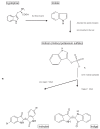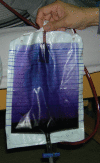Purple urine bag syndrome in nursing homes: ten elderly case reports and a literature review
- PMID: 19281065
- PMCID: PMC2682405
- DOI: 10.2147/cia.s3534
Purple urine bag syndrome in nursing homes: ten elderly case reports and a literature review
Abstract
Purple urine bag syndrome (PUBS) is a rare occurrence, in which the patient has a purple-colored urine bag following urinary catheterization for hours to days. Most of authors believe it is a mixture of indigo (blue) and indirubin (red) that becomes purple. Previous study showed that PUBS occurred predominantly in chronically catheterized, constipated women. We collected 10 elderly patients with PUBS in two nursing homes. The first two cases were identified by chart review in 1987 and 2003, and then later eight cases (42.1%) were collected among 19 urinary catheterized elderly in the period between January 2007 and June 2007. In the present report, PUBS probably can occur in any patients with the right elements, namely urinary tract infection (UTI) with bacteria possessing these enzymes, diet with enough tryptophan, and being catheterized. Associations with bed-bound state, Alzheimer's, or dementia from other causes are reflections of the state of such patients who are at higher risk for UTI, and hence PUBS occurred. Although we presented PUBS as a harmless problem, prevention and control of the nosocomial catheter-associated UTIs (CAUTIs) has become very important in the new patient-centered medical era. Thus, we should decrease the duration of catheterization, improve catheter care, and deploy technological advances designed for prevention, especially in the elderly cared for in nursing homes.
Figures



References
-
- Barlow GB, Dickson JAS. Purple urine bags. Lancet. 1978;28:220–1.
-
- Chiou YK, Yiang GT, Wang CH, et al. Purple urine bag syndrome – a case report. Tzu Chi Med J. 2005;17:279–81.
-
- Hampton S. Nursing management of urinary tract infections for catheterized patients. Br J Nurs. 2004;13:1180–4. - PubMed
Publication types
MeSH terms
Substances
LinkOut - more resources
Full Text Sources
Medical

